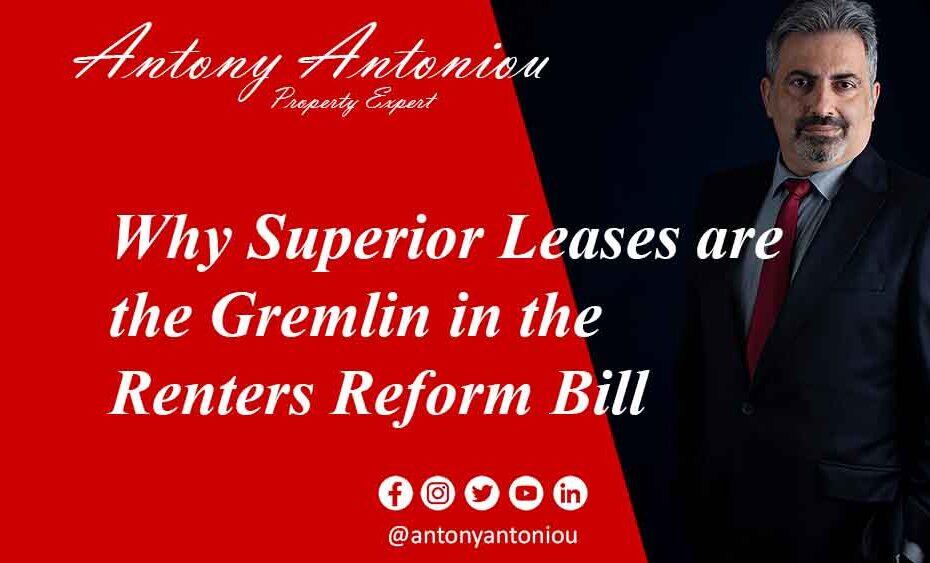Why Superior Leases are the Gremlin in the Renters Reform Bill
*Introduction*
In my latest video, I delved into the upcoming Renters Reform Act and dissected my thoughts on this potential legislation. The proposed bill has raised significant concerns, and I’m here to discuss a particularly intriguing aspect – the concept of a “superior lease.” In addition, I’ll touch upon the implications of this lease type and whether it could lead to unintended consequences. Join me as we navigate the intricacies of this matter and ponder its potential impact on the rental landscape.
**Understanding the Superior Lease**
Before we dive into the nuances of a superior lease, let’s get acquainted with this legal concept. Essentially, a superior lease holds a higher authoritative position compared to the lease granted to a tenant. Picture this: you’re purchasing a flat in the UK, and it’s leasehold property. There are terms and conditions outlined in the lease, and any breach could result in lease forfeiture. This, in turn, might provide grounds for the property’s freeholder to evict the tenant.
*What is a ‘Superior Lease’?*
A “superior lease” typically refers to a situation in real estate or property law where there are multiple leases involving the same property. In this context, a superior lease is a lease that holds a higher or more authoritative position in terms of its rights and obligations compared to another lease on the same property. The legal definition can vary depending on the jurisdiction and the specific context in which the term is used, but generally, a superior lease is one that takes precedence over a subordinate or inferior lease.
For example, let’s say there is a building with two leases in place: Lease A and Lease B. If Lease A was signed before Lease B and contains terms that give it priority or superiority over Lease B, then Lease A would be considered the superior lease. This could mean that the rights and obligations of the tenant under Lease A would take precedence over those of the tenant under Lease B.
Superior leases can arise in various property scenarios, such as in commercial real estate where a property owner might lease different portions of a building or land to different tenants. The terms and conditions outlined in each lease agreement will dictate the hierarchy of the leases.
It’s important to note that specific legal definitions and implications can vary based on local laws and regulations, as well as the language used in the lease agreements. If you’re dealing with a legal situation involving superior leases, it’s recommended to consult with a qualified attorney who specializes in real estate law in your jurisdiction to get accurate and up-to-date advice.
Superior leases come into play when there’s a lease that trumps the one held by the tenant. For instance, the original lease might be assigned from a previous leaseholder to you, the new tenant. If the original lease gets breached and forfeited, the freeholder could evict you based on the grounds of this superior lease.
**Exploring a Potential Loophole**
Now, let’s indulge in some hypothetical thinking. If we’re to play devil’s advocate, there’s an intriguing scenario to consider. With the impending Renters Reform Bill, landlords might seek ways to protect their interests and possibly exploit certain aspects of the law. One possible approach could involve renting out a property not to a tenant directly but to a Special Purpose Vehicle (SPV).
To circumvent any suspicions of evading the law, this SPV could be linked to a family member, a friend, or even a stranger. The SPV would then lease the property to the tenant. The crucial point here is that the lease between the freeholder and the SPV would be a superior lease, potentially giving the freeholder the right to evict the tenant under certain circumstances.
**The Challenges and Considerations**
This scenario presents a complex challenge for lawmakers. Closing this loophole could inadvertently affect a vast number of properties and their mortgageability for buy-to-let purposes. It’s a delicate balancing act: addressing one issue might lead to the unintended closure of another. Striking the right balance while safeguarding the interests of tenants and property owners is a daunting task.
**Conclusion: A Call for Comprehensive Reform**
While pondering these potential loopholes, it’s crucial to remember the bigger picture. The Renters Reform Act, if it comes to fruition, should be focused on comprehensive reform that improves housing standards, benefits tenants and landlords alike, and ensures clear health and safety regulations. Knee-jerk reactions and superficial changes might exacerbate existing problems rather than solve them.
It’s undeniable that both landlords and tenants deserve fair treatment. The overwhelming majority of rental experiences are positive, with issues arising from a minority. The government’s role should be to address these issues without penalizing the responsible parties, be they landlords or tenants.
In the end, the Renters Reform Act should be a product of careful consideration, broad consultation, and a deep understanding of the rental landscape’s complexities. As we await developments in this realm, it’s essential to keep the conversation alive and engage with legal experts, stakeholders, and the general public to ensure that any reforms truly serve the greater good.
**Your Thoughts Matter**
If you’re well-versed in property law or have encountered cases related to superior leases, your insights are invaluable. Let’s continue this discussion and explore where this potential loophole might lead. Share your experiences, thoughts, and ideas in the comments section. Together, we can unravel the intricate threads of legislation and work toward a rental system that benefits all parties involved.
Thank you for joining me in this exploration. Until next time, stay informed and engaged in the evolving world of property law and rental reform. Goodbye for now, and see you in the next conversation!
Read my summary of the Renters Reform Bill HERE:

